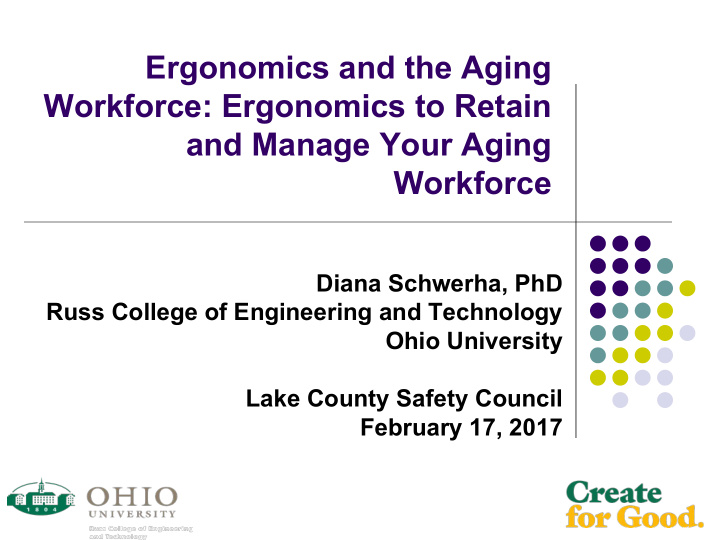



Ergonomics and the Aging Workforce: Ergonomics to Retain and Manage Your Aging Workforce Diana Schwerha, PhD Russ College of Engineering and Technology Ohio University Lake County Safety Council February 17, 2017
Things are changing 2
Today’s Talk l Demographics l Continuum of worker abilities l Knowledge transfer l Next Steps
Demographics
At your workplace l Workers may be likely to work longer l Type of work and retirement benefits are significant factors for when a person retires l Older workers may change jobs, so you may have a new employee who is older l Because older workers tend to be off more when injured, prevention is key
In what areas do normal age-related changes occur? l Physical l Vision, hearing, work physiology, lifting, cold stress, reaction time, falls l Cognitive l Stress, working memory, distraction, divided attention
Design tasks to match demands with worker abilities Job Requirements vs. Abilities Job Requirements vs. Abilities Performance Performance demands demands ability ability 0 20 40 60 80 0 20 40 60 80 Age (years) Age (years)
Vision l Many people over 40, can’t bring close objects into focus (safety glasses) l Adapting to the dark is more difficult l Peripheral vision decreases l Decreased transmission of light l Increased problems with glare
Consider older adults’ vision as noisier—we must boost the signal l Increase the size of the font l Ensure enough contrast l Use sans serif font l Allow users to change font size with browser software Avoid blue on grey
Improve individuals’ interaction with computer interfaces l Guidelines for designing web pages for older adults: l Making your Website Senior Friendly l Font size, contrast, organization, mental models, menu levels l http://www.nlm.nih.gov/pubs/staffpubs/od/ocp l/agingchecklist.html
Safety glasses http://www.amazon.com/Bifocal-Safety-Glasses-Yellow-Lens/dp/B000CCD8VY http://www.phillips-safety.com/Bifocal-Safety-Glasses/Index.htm
Glare Film http://www.tropictint.net/residential.html http://www.hotspottinting.com/resbenefits.htm
Text Magnifiers or increase font size
Hearing l Age-related and noise induced l Men often lose ability to hear high frequency sounds (above 4000 Hz) l Noise induced hearing loss increases the problem l Additional challenges with background noise
Increase perception and understanding of auditory signals l Allow users to change volume l Use frequencies below 4000 Hz l For warning signals, use 500 to 2000 Hz l Use redundant signals l Minimize background noise (or at least understand where it is and how it affects performance)
NIOSH Hearing Simulator http://www.cdc.gov/niosh/mining/products/product47.htm
Work scheduling l Determine if flexible work schedules are possible l See what proportion of workers would stay if given options l Job Rotation l Watch for changing shifts (difficult as we age!)
Movement l Muscle mass decreases start around age 20 and continue throughout one’s lifetime l Reaction times slow l Slips and falls can be a bigger risk for older workers l Workers may adopt compensatory actions Losses in muscle mass and strength can be partially overcome or delayed by regular weight-bearing exercise
Lower Back Pain l Can affect up to 80% of people during their lifetime l Back injuries have high recurrence rates ranging from 40-70% l Back injuries can result for a variety of reasons l Back injuries are expensive and have a high social cost (but you already know this!)
Rely on good design for lifting tasks l Heavy lifting jobs should be evaluated for all ages of workers l Mechanical assists should be used to help all ages of workers l If you can’t minimize weight, make it too heavy to lift l Ask suppliers for boxes with better coupling l Don’t give the heavy lifting to the younger people!!!! l Risk of injury with inexperience l Younger workers today are tomorrow’s older workers
Hand Tools and Grip Strength l Preventive maintenance will reduce forces needed l Changes in grip strength could be a sign of an injury l Job rotation so that different muscle groups are used
Identify risks for slips, trips, and falls l Locate transition areas (going from light to dark, or from dry to wet) involve higher risks for falls l Because workers change their gait according to environmental conditions, warning signs can be valuable l Investigate safety footwear (tread and additional friction devices) l Investigate alternate walkways
Aerobic capacity l Older workers tend to lose aerobic capacity before strength l Aging workers may have complications due to multiple conditions (obesity, high blood pressure) l Especially important with heat stress l Wellness programs may help
Job Design and Fatigue l In our preliminary research findings, at least half respondents stated that they are both mentally and physically tired by the end of the day l Excess fatigue could lead to burnout l Burnout is a retention issue
Knowledge Transfer
Most companies are at risk for lack of good programs to ensure knowledge transfer l Have you done a knowledge transfer audit? l Do you know where your gaps are? l What types of knowledge transfer programs do you have in place? l Good work procedures, documentation? l Mentoring? l Or none, all knowledge is tribal…
Next Steps: Things to Consider l Injury and Near Miss Audit l Where are your injuries or near misses occurring? l In which age groups? l In which tenure? l Safety Involvement l Safety teams, Age-diverse? Experience diverse? l Consider the work environment holistically l Safety integrated with process improvement l Team involvement
Things to consider l Where will you have individuals retiring? l Succession planning audit? l Where are your gaps in knowledge transfer? l Utilize process improvement techniques to get age-diverse groups working together (e.g., lean tools) l Try new things and reward effort!
Resources: NIOSH
Resources: Boston Center for Aging and Work
Resources: Ohio University Training Modules l Aging and Ergonomics Online training l Will be available Summer 2017 l Looking for reviewers l Will have assessments and hoping to be able to give CEU l Contact me at schwerha@ohio.edu for more information l Integrating Safety with Process Improvement l Available after June 1, 2017
Questions? l Diana J. Schwerha, PhD l schwerha@ohio.edu l 740.593.1577
Recommend
More recommend